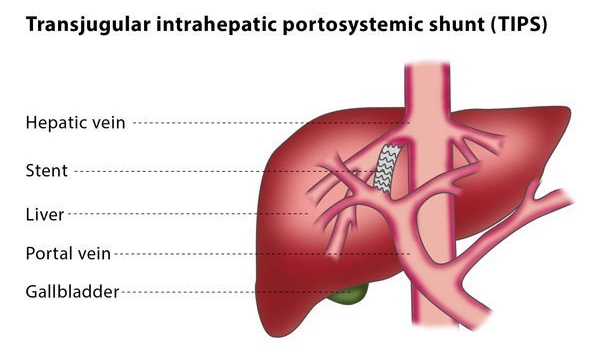Transjugular intrahepatic portosystemic shunt (TIPS)
What is TIPS?
A shunt is an artificial passage which allows fluid to move from one part of your body to another. A transjugular intrahepatic portosystemic shunt (TIPS) connects the vein which brings blood from your gastrointestinal tract and intra-abdominal organs to your liver, and the vein from your liver to the right part of your heart.
How does the procedure work?
You will be conscious but sedated for the procedure, which the interventional radiologist will carry out using fluoroscopy and ultrasound for guidance.
The interventional radiologist will puncture your jugular vein on the right side of your neck with a needle and will then insert a vascular sheath over a wire into the inferior vena cava. They will explore the hepatic vein with a catheter designed for this purpose.
The interventional radiologist will puncture the portal vein through the liver with a special needle and position a wire between the two veins. After the area has been dilated, a stent or stent graft will be placed between the portal and hepatic vein to create a lasting connection.

Why perform it?
The TIPS procedure is usually performed in patients with liver cirrhosis. If you have this condition, your normal blood flow through the liver is blocked by scar tissue within the liver, which increases the pressure in your portal vein.
The increased pressure in your portal vein makes thin veins in your gullet or stomach become abnormally enlarged and so at risk of bleeding. Another symptom of liver cirrhosis is an abnormal collection of fluid (ascites) in the abdominal cavity.
You may be advised to undergo TIPS if you have varices which bleed acutely or recurrently and have not responded to other treatments.
Once the interventional radiologist has placed the shunt, the pressure in the portal vein decreases, protecting the area from bleeding and reducing the ascites.
What are the risks?
Because a liver suffering from cirrhosis is shrunken and the liver tissue can be very hard, it is possible to puncture the outside of the liver. This can cause bleeding which requires further treatment.
Another risk is that after the TIPS procedure ammonia from the intestine might bypass the liver and be delivered to the brain, which may result in a condition called hepatic encephalopathy, the symptoms of which range from mild (alterations in thinking) to severe (confusion and coma).
Due to the shunt, there is an increased amount of blood flowing directly to the heart, which can cause heart failure. If you experience this, your doctor will decrease or disrupt the blood flow through the TIPS.
Bibliography
- Krajina A, Hulek P, Fejfar T, Valek V. Quality improved guidelines for transjugular portosystemic shunt (TIPS). Cardiovasc Intervent Radiol 2012; 35:1295-1300.
